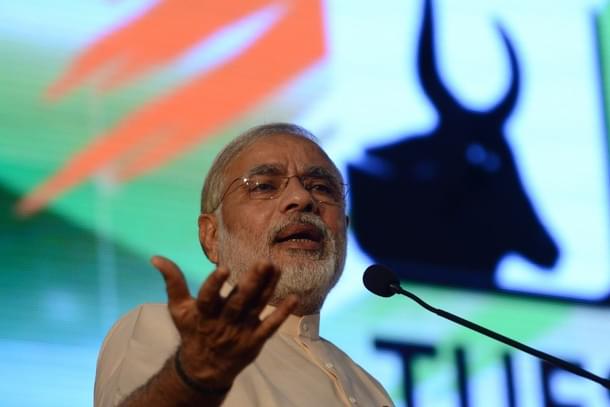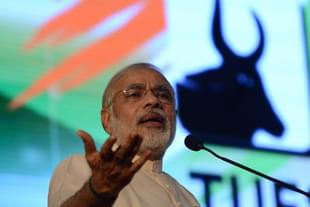Politics
Tipping Point
Gautam Mukherjee
Aug 20, 2015, 08:30 PM | Updated Feb 24, 2016, 04:31 PM IST
Save & read from anywhere!
Bookmark stories for easy access on any device or the Swarajya app.


The prime minister’s second address from the ramparts of Red Fort for the 69th Independence Day, long at 90 minutes, was notable for its focus on the poor, the farmer, the dalit, the tribal.
It was something of a report card, with facts and figures on the progress made towards helping these sections over the last fifteen months. His anti-corruption stand, and measures to curb the stashing abroad and bringing back of black money, also featured prominently for its anti-fat-cat feel.
The speech, delivered once again without benefit of bullet-proof vest or canopy, despite the high security threat, was clearly designed to blunt the opposition onslaught. Modi took pains, via his inclusions and exclusions, to refute by implication, opposition and media charges that he is running a government only for the rich and the corporates.
But, in the process, some of the trademark excitement and flair of his oratory was clearly sacrificed. There was very little inspirational coinage of acronyms and slogans, and no update on the ‘Make in India’ from a year before. The only bit of vintage Modi was in the vision: ‘Start-up & Stand Up’, and its pithy slogan to match.
It is a pity that the recent bitterness of the principal opposition’s attacks in particular, possibly out of existential desperation, has had its effect on the prime minister’s usual ebullience. He was noticeably measured and defensive. Even the colour of his safaa was less flamboyant.
And yet, there was a sense of confidence and determination that has come about with his 15 months on the job, and the self-knowledge that he is succeeding; despite the blistering and often unfair criticism.
Tipping Point, abest-selling book by sociologist Malcolm Gladwell (2000), defines its title and main message as:‘The moment of critical mass’. And while Modi is still building up to it, his critical mass; the evidence, like the tenaciously held Iranian mission to refine its own nuclear fuel, is definitely building.
The same book, amongst its many insights, has this to say: ‘Ideas and products and messages and behaviours spread like viruses do.’ So wheeling it back a bit, just before Independence Day 2015, what do we need to make of Rahul Gandhi declaring he was there to ‘stop the RSS and Modi’?
This, after assuming the mantle, along with his mother, to drive the Monsoon session of parliament into being a complete washout . Is the mother-son duo, and imposition of strident, far-left policies on the Congress, feeling particularly threatened?
Not to be outdone, Modi has also asked teams of one minister plus four BJP MPs to visit all 44 Lok Sabha constituencies of the Congress MPs, and those of their firm allies, the Left, who also have 9 seats. They are to explain the parliamentary goings-on to the voters there, and expose the shenanigans of their elected representatives, including their wilful blocking of important legislation. And, how their MPs are not just being an unhealthy opposition, using the illegitimate politics of the trade union dharna inside parliament, where debate and discussion is the process laid down; but are out-and-out ‘anti-development’.
There are lines drawn in the sand now, for ‘battle’, rather than discourse, as the President Pranab Mukherjee put it, in his independence eve address. This is probably irreversible, because it seeks, not parliamentary style compromise and consensus, but the decisive win of one ideology and grouping over the other.
The sharply stepped up collision course picked on by Congress at this stage is perplexing, because the rejection of its welfare politics at the hustings took place only 15 months ago. Perhaps it is now pinning its hopes on vigorously denigrating the BJP and working to see it fail in its mission to bring vikas to the people.
The BJP, on its part, is equally unwilling to give the Congress the importance it seeks. There is a considerable and ongoing slanging match.
Congress repeatedly points out that it is only paying BJP back in its own coin for all its obstruction of legislative business during the UPA period. The BJP counters by pointing out the substantial number of major scams under the UPA that had to be exposed. The Congress cites the alleged wrong-doings in Rajasthan, Madhya Pradesh and on the part of the foreign minister, and demands its pound of flesh. The BJP rakes up wrong-doings of the Congress High Command over the decades, misdeeds of a much higher order, to put things in perspective. The acrimony on both sides is immense, polarising, and seemingly irreconcilable.
Congress says it represents the aam aadmi and the poor, notwithstanding Arvind Kejriwal’s kidnap, hijack, and heist of this particular platform! Rahul Gandhi has responded by copying some of the AAP’s tactics, demagoguery, and media hunger; and vows that he will see to it that the rights of ‘the people’ are not stolen by the ‘pro-business BJP’ .
BJP protests it is deeply pro-poor too, and now the Independence Day speech underlines it. But the Modi government is very clear that it is committed to ‘development’ as the means to the sustainable upliftment of the poor.
So which side is going to win this now vicious battle for the hearts and mind of the Indian voting public?
Fortunately for Modi and the NDA , there are four years to go till 2019, in which to prove the case for its model of governance. This, essentially Gujarat model, is beginning to bear fruit elsewhere.
With an unprecedented $ 5 billion in single location investment and $20 billion pledged across different states by 2020, Taiwan HQ’d Foxconn has made a dramatic beginning. It is building, first in Maharashtra, an R&D centre, and mega manufacturing plant to make the innards of cellphones etc. that will employ thousands.
There is no ambiguity. Chief minister Fadnavis has allocated 1,500 acres of land near Pune for the project that even elicited envious comment from China. The young and enthusiastic Fadnavis not only played a highly proactive role in bagging this investment, but is proving the Modi vision of competitive federalism in the states.
There will, no doubt, be many more such big ticket foreign investments to come; and not just in the BJP ruled states. Karnataka, the present IT capital of the country, in nominal competition with Andhra Pradesh, and Haryana, under its Congress chief minister Siddaramiah, seems to be resonating with Modi’s vision. He too is promoting business and industry, and does not regard this activity as being ‘anti-poor’.
Whereas, the Gandhi scion seems to have a very different vision. He is making every effort to declare himself and his party opposed to the forces associated with big business. He thinks this will be electorally sound. But, in the absence of power, and money flowing into the High Command’s central coffers, is this going to be sustainable? And how long before the Congress-run states, which need to generate revenue and support their central leadership to boot, decide to protest?
The non-Congress, non-Left opposition, mostly regional parties representing other state bastions and governments, are also not comfortable with the disruption in parliament. And the central government, taking a cue from this, is hoping to still pass the GST Bill by calling a special session of parliament shortly.
Meanwhile, having just burnished his pro-poor credentials, Modi is back from the UAE after enthusing the lakhs in the Indian diaspora there pitching India as an investment destination for some of the $800 billion in sovereign funds into our manufacturing industry and infrastructure development.
Gautam Mukherjee is a political commentator whose columns figure regularly in different right-of-centre media outlets




